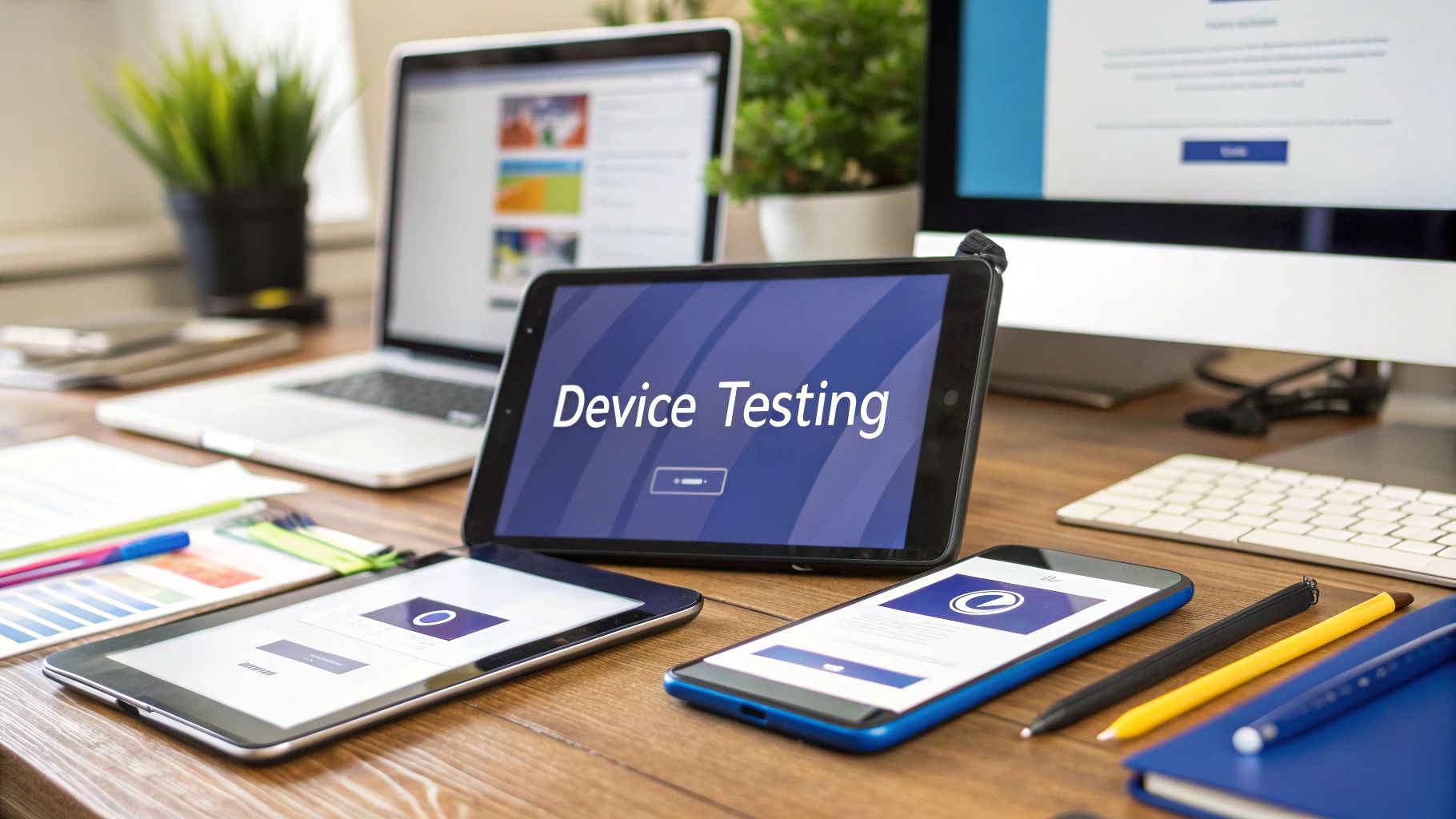Why Mobile Testing Is Critical for Modern Success

Your customers expect flawless experiences when visiting your website from any device. Mobile testing has become essential – not optional – for businesses that want to succeed online. When you overlook mobile users, you risk losing a huge portion of potential customers who primarily browse on their phones and tablets.
The numbers tell a clear story: mobile devices now generate more web traffic than desktop computers. Understanding how people use your site on mobile is crucial because phone users behave quite differently. They're often multitasking, have limited time, and rely on touch interactions instead of mouse clicks. By tracking key metrics like bounce rates and conversion rates on mobile, you can spot problems and make improvements that drive real business growth. Learn more about mobile analytics.
The Business Impact of Mobile Testing
Poor mobile experiences directly hurt your bottom line. When your site isn't mobile-friendly, visitors quickly leave without taking action, leading to high bounce rates and lost sales opportunities. Even worse, frustrated mobile users often share negative experiences with others, damaging your brand's reputation and trustworthiness.
Mobile User Behavior: Key Considerations
People interact with mobile sites in unique ways that require special attention during testing. Here are the main factors to consider:
- Smaller Screens and Touch Navigation: Mobile layouts must be easy to use with fingers on small screens. Testing ensures your navigation, buttons and content work smoothly with touch input.
- Varying Network Conditions: Mobile users switch between Wi-Fi, 4G, and weaker connections. Testing across different network speeds helps deliver consistent experiences.
- Different Device Capabilities: With countless phone and tablet models in use, testing across various screen sizes and operating systems is essential for broad compatibility.
Prioritizing Mobile Testing: A Strategic Approach
Effective mobile testing requires more than basic functionality checks. Start by mapping out your key user paths – like checkout flows and contact forms – and test these thoroughly across devices. Focus first on the features that directly impact conversions and revenue. This targeted approach helps you deliver smooth mobile experiences that turn visitors into customers while demonstrating clear returns on your testing investment.
Building Your Mobile Testing Toolkit

Getting your website to work flawlessly on mobile takes more than just checking it on your phone. You need the right set of tools to thoroughly test how users experience your site across different devices and network speeds. With a thoughtfully assembled toolkit, you can catch and fix issues before they frustrate your visitors.
Essential Tools for Mobile Website Testing
The key to effective mobile testing is using a mix of complementary tools. Here are the most important ones for your toolkit:
-
Browser Developer Tools: Most modern browsers like Chrome include built-in tools to simulate mobile devices and test responsiveness. You can quickly switch between device sizes and slow down network speeds to see how your site performs. This is perfect for initial testing.
-
Mobile Device Simulators: Tools built into Xcode and Android Studio give you a more realistic view of how your site works on specific devices. While not perfect matches for real hardware, they let you test device-specific features.
-
Cross-Browser Testing Services: Platforms like BrowserStack and Sauce Labs give you access to real mobile devices for testing. You can automate tests across many devices and browsers to ensure broad compatibility.
-
Remote Debugging Tools: Connect physical devices to your computer with tools like Chrome Remote Debugging to inspect code, monitor network activity, and measure performance in real-world conditions.
Choosing the Right Combination of Tools
One tool can't do it all. The best approach is picking tools that work together based on your needs and budget. Small teams often start with browser tools and free simulators, then add paid testing services as they grow. This gives you solid coverage without overspending.
Building a Scalable Testing Workflow
Beyond just tools, you need a clear testing process. Map out what to test, how to test it, and when testing should happen. For more on gathering user feedback, check out How to master in-app surveys for mobile feedback. Document your test cases and results to track progress and spot patterns. This structured approach helps you maintain quality as your site grows and mobile technology changes.
Mastering Mobile-Specific Challenges
Mobile testing requires much more than just checking how your site looks on a smaller screen. You need to put yourself in your mobile users' shoes and understand their daily challenges. Consider how they navigate with touch instead of a mouse, deal with fluctuating network speeds, and interact with content on compact displays. Getting these details right can mean the difference between keeping or losing mobile visitors.
Testing for Responsive Design and Touch Interactions
The foundation of good mobile testing starts with responsive design that adapts seamlessly across devices. Test your site thoroughly on various screen sizes, from the smallest phones to the largest tablets, to verify that all elements scale and rearrange properly. Remember that finger taps behave differently than mouse clicks – buttons need adequate spacing and size for easy interaction. For instance, menu items that work fine with a precise mouse cursor may be frustratingly small targets for fingers on a touchscreen.
Addressing Mobile-Specific Features and Functionality
Many websites now include features built specifically for mobile users, like location services and mobile payments. These need careful testing on real devices to catch compatibility issues early. For example, a payment system that works perfectly on desktop may have glitches when accessed through mobile browsers. Pay special attention to how these mobile-centric features affect the overall performance and user flow of your site.
Mobile users have little patience for poor experiences. The numbers tell a clear story: 70% of visitors will abandon slow-loading sites, 29% leave immediately if they don't find value, and 61% won't return after encountering problems. For more insights, check out Mobile Application Testing Trends. When you find issues, document them clearly – here are some helpful tips: 7 Tips to Report Mobile App Bugs Faster.
Building a Systematic Approach to Mobile Testing
The best development teams create detailed test plans covering different scenarios and devices. They set up clear processes for tracking and fixing bugs based on priority. This organized approach helps catch issues early and ensures consistent quality across all mobile experiences. When you test methodically, you can focus on delivering a smooth, reliable experience that keeps mobile users coming back.
Optimizing Mobile Performance for Real Results

Getting your website to work on mobile devices is just the first step. The real difference comes from refining its performance to deliver exceptional user experiences that drive measurable business results. Success requires looking beyond basic functionality to focus on the specific metrics and optimizations that leading websites use to excel in mobile.
Key Metrics for Mobile Success
Understanding and tracking the right performance indicators gives you clear data to improve your mobile experience. By monitoring these key metrics over time, you can pinpoint exactly where to focus your optimization efforts:
- Page Load Time: Your site should load in under three seconds on mobile devices. Slower loads directly increase bounce rates and user frustration.
- Time to First Byte (TTFB): This shows how quickly your server responds to requests – a core indicator of backend performance.
- First Contentful Paint (FCP): Users need to see content appear quickly to know the page is loading. This metric tracks when the first elements become visible.
- Largest Contentful Paint (LCP): The time until your main content loads significantly impacts how users perceive your site's speed.
These metrics work together to give you a complete view of mobile performance.
Practical Techniques for Improvement
Once you know where to focus, several proven optimization techniques can boost your mobile experience:
- Optimize Images: Use compression and next-gen formats like WebP to reduce image sizes without sacrificing quality.
- Leverage Browser Caching: Store commonly used files locally so returning visitors get faster page loads.
- Minify CSS and JavaScript: Remove unnecessary code characters to reduce file sizes and speed up downloads.
- Implement a Content Delivery Network (CDN): Serve content from servers closer to users for better global performance.
Regular testing helps ensure these optimizations continue delivering results as your site evolves.
Balancing Performance and Features
While speed matters, you also need the right mix of functionality. Think of it like packing for a trip – you want everything essential without weighing yourself down. This means carefully choosing which features truly serve your mobile users.
Consider animations as an example. While they can enhance visual appeal, they may slow down less powerful mobile devices. Focus first on core features that directly help users accomplish their goals. Tools like BugSmash can help teams identify and fix performance issues before they impact real users. The key is finding the right balance between rich functionality and consistently fast performance that keeps users engaged.
Creating a Cross-Device Testing Strategy That Works

Building a strong mobile presence starts with thorough testing across multiple devices and platforms. Simply testing on your personal phone isn't enough – you need a structured approach to ensure your website works smoothly for all users. Here's how to create an effective testing plan that balances thorough coverage with practical resource limits.
Defining Your Device Matrix
Start by identifying which devices matter most for your testing efforts. While testing every single mobile device isn't realistic, focus on the ones your target audience actually uses. Tools like Google Analytics provide valuable data about which devices your visitors prefer.
For instance, if 80% of your mobile traffic comes from iPhones, make iOS testing your priority. Look at operating system versions too – you'll want to verify your site works on both older and current software versions that your users have installed.
The Power of Test Automation
Testing manually across multiple devices takes considerable time and effort. This is where test automation becomes essential. Platforms like BrowserStack and Sauce Labs let you run automated tests on many devices at once, helping you spot problems early in development.
But automation isn't everything – some aspects of user experience need a human touch. Elements like touch interactions and visual design quality are best evaluated through manual testing. The most effective approach combines automated testing for core functions with hands-on testing for user experience details.
Streamlining Result Analysis with BugSmash
Once testing is complete, you need an efficient way to analyze results. This means gathering feedback, ranking issues by importance, and monitoring fixes. BugSmash makes this process smoother by creating one central place for all testing feedback.
Testers can mark up screenshots directly in BugSmash, pointing out specific issues on different devices. This beats dealing with long email chains or confusing spreadsheets. When feedback from various devices flows into one organized system, your team can move faster to fix problems and improve the user experience.
Implementing Mobile Testing Best Practices
Testing your mobile website goes far beyond basic functionality checks. The most successful teams treat mobile testing as a systematic process, not a one-time task. Let's explore how to build and maintain a strong mobile testing strategy that catches issues early and delivers consistent quality.
Creating a Comprehensive Test Plan
A solid test plan is your foundation for effective mobile testing. Think of it as your roadmap – one that outlines exactly what you'll test, which devices you'll use, and what success looks like. This structured approach helps ensure nothing falls through the cracks.
- Define Clear Goals: Map out exactly what you want to verify – whether that's browser compatibility, core features, or performance metrics. Having focused goals keeps your testing efficient and productive.
- Select Target Devices: Research which mobile devices your users actually use, then concentrate your testing on those specific models. This targeted approach helps you deliver the best experience to your core audience.
- Focus on Critical Features: Some website elements matter more than others. Put extra attention on testing crucial paths like checkout flows and contact forms, since bugs in these areas directly impact your bottom line.
Executing Your Mobile Testing Strategy
Once your plan is ready, it's time to put it into action. The most effective approach combines both manual and automated testing to get a complete picture of how your site performs for real users.
- Hands-on User Testing: Nothing beats having real people interact with your site. They catch subtle issues that automated tools might miss, like confusing navigation or unclear instructions.
- Smart Test Automation: Use tools like BrowserStack and Sauce Labs to automatically check compatibility across devices. This frees up your team to focus on more complex testing scenarios.
- Network Testing: Check how your site performs on different connection speeds – from fast Wi-Fi to slower mobile networks. Your site needs to work well regardless of how users connect.
Documenting and Analyzing Test Results
Detailed documentation helps you track progress, spot patterns, and share findings effectively with your team. Good records make it easier to fix issues quickly and prevent them from happening again.
- Clear Bug Reports: When you find an issue, document it thoroughly. Include screenshots, reproduction steps, and device details. Tools like BugSmash let you visually highlight problems right on the page.
- Performance Tracking: Keep tabs on key metrics like load times and Time to First Byte (TTFB). Having this data helps you measure the impact of your optimizations.
- Regular Team Updates: Share testing results often with your team. This keeps everyone aligned and helps solve problems faster through collaboration.
By following these testing practices consistently, you'll build a reliable process that catches issues early and maintains high quality standards. Remember – good mobile testing isn't a one-time event, but an ongoing commitment to delivering the best possible user experience.
Want to improve how your team manages mobile website testing and feedback? Try BugSmash to streamline your testing workflow for websites, videos, PDFs, images and more. Start testing smarter with BugSmash.